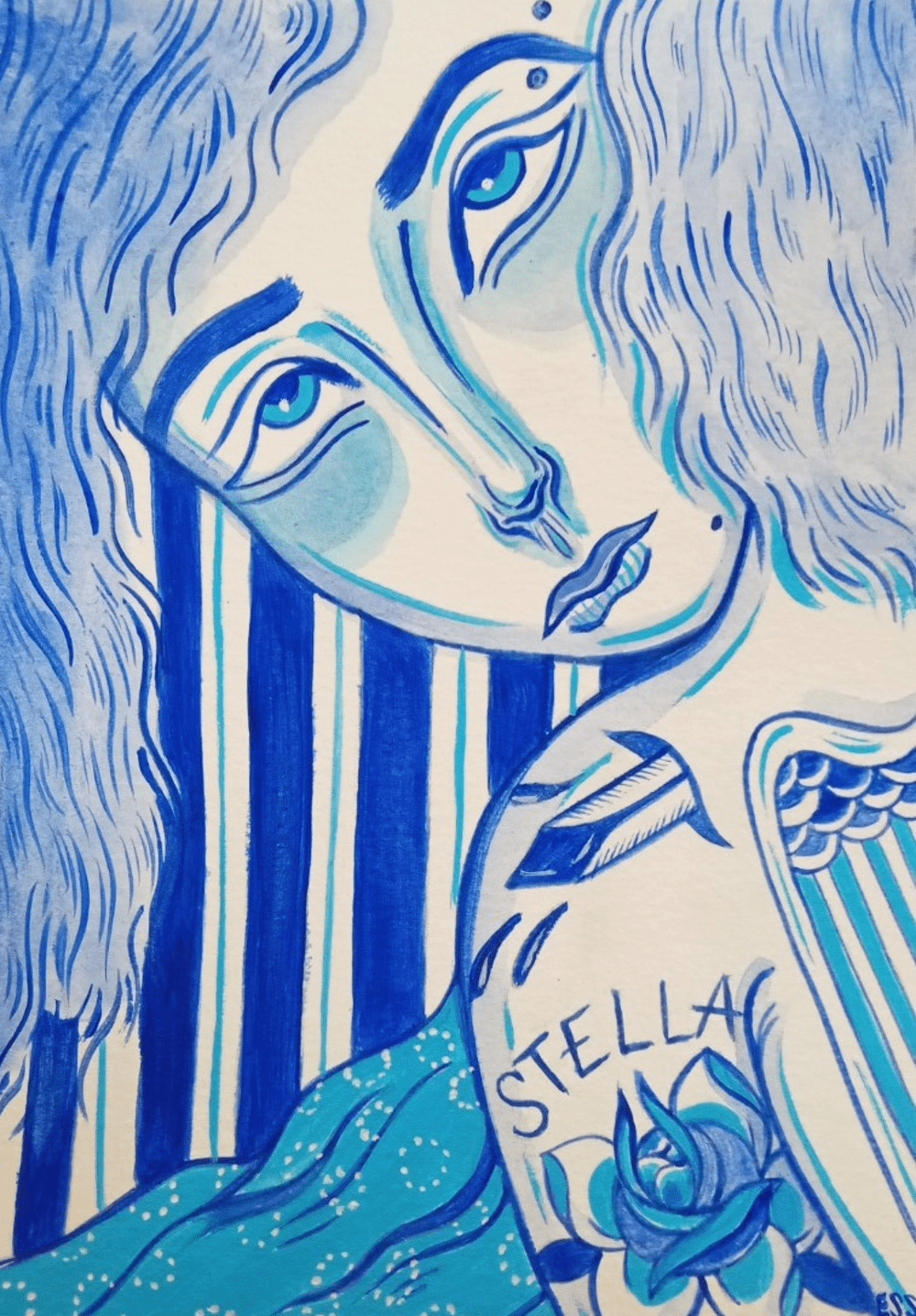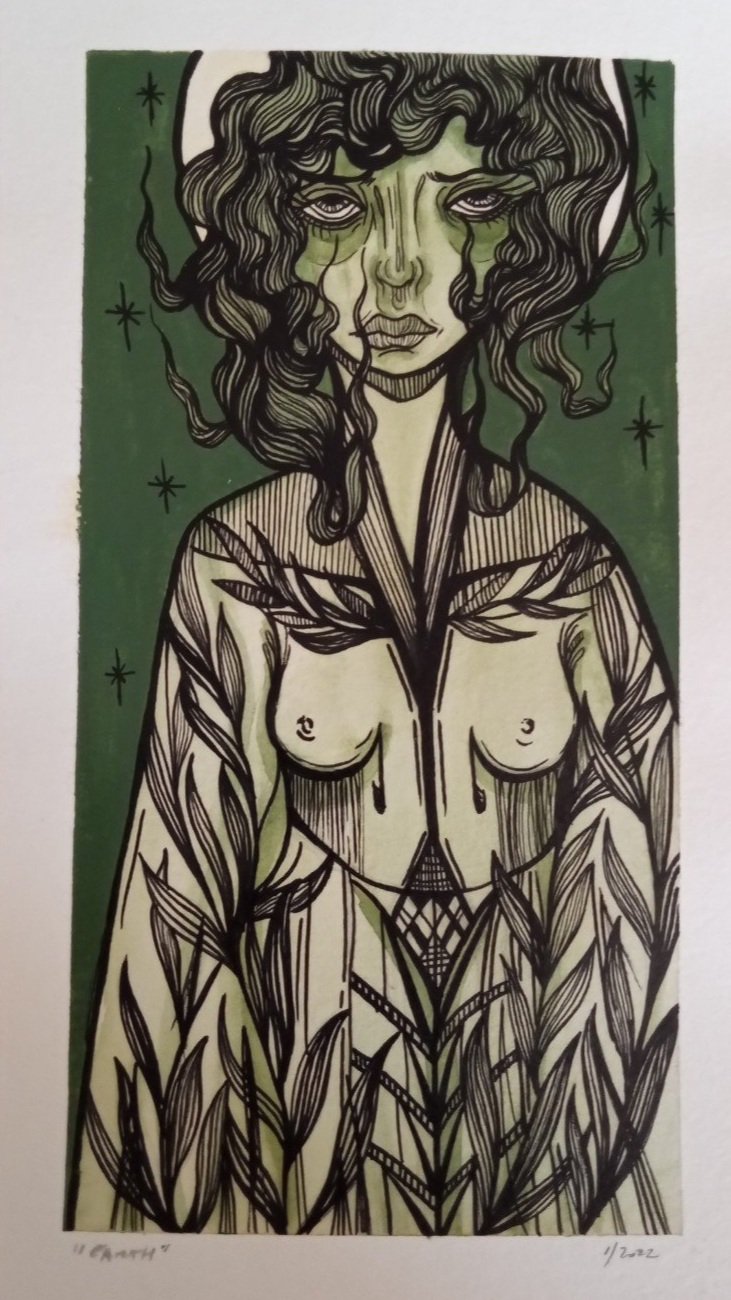Interview
Alex Smith (ESS22)
ESS22 was born in Chicago, IL in 1984. Primarily a self-taught artist, ESS22 focuses on painting female figures using ink and acrylic on paper. Their emotive figurative artwork and illustrative style draws upon more than a few influences, including: German expressionism, an intuitive aesthetic, printmaking, textiles, alternative/punx aesthetic, and tattoo.
What is your background and how did you start your journey in the art world?
“My background in art is a combination of a few different elements. First, I attended (and dropped out of a now-defunct) commercial design school for a few years. Following that, I had the privileged opportunity to work as a tattooist alongside American, European, and Asian artists, which still heavily influences me today. And since a teenager, visits to the library for tutorials and reference material helped to push and grow my continuing art education. Although, I am capable of drawing from my imagination, I still believe it is important to gather reference materials. It’s vital to continue learning from life, moments, and other people to keep your art interesting and fresh. As an artist, you are constantly forced to continue learning, growing, and maintaining a sense of playfulness to make work that connects to others. This is a challenge that keeps me engaged and interested in creating artwork. I want to see how far I can go and am very hard on myself.”
What inspires you?
“When it comes to creating my artwork, I am inspired by powerful female figures. Growing up, I was lucky to interact with a no-nonsense English woman who worked as a principal at a local school. I fell in love with how she maintained a fine home, drank and smoked cigars at her leisure, and was an amazing baker. Another woman that made an impression on me was a (late) art collector and enthusiast for fine art photography. She invited me into her home and showed off her extraordinary collection of original photos, prints, encaustics, flat files, and plants. Pretty much every square inch of her home was covered with artwork, even the bathroom! She wanted me to go to a fine art school and study photography and turn away from tattooing, but I didn’t listen. However, I appreciated her taking an interest in my pursuit of the creative and fine arts. And, she forgave me for being stubborn and wanting to tattoo because I at least was taking classes in lithography and relief printmaking.
Besides being inspired by strong, educated women with discerning taste who live their life on their terms, and believe in collecting fine artworks and supporting personal interests without shame or fear, a few more things influence me and my path. Working with textiles, learning how to sew, knit, and appreciating creating and working with your hands in a specific manner to achieve a desired end-goal continue mean a lot to me. Getting to work on theater sets, installing flooring, painting walls, and learning from workers in the trades made an impression on me to maintain a good work ethic. Focusing on quality and good execution is something I strive to achieve and struggle with often.”
What themes do you pursue? Is there an underlying message in your work?
“Currently, I focus on painting female figures with an alternative or edgy aesthetic. Seeking a career in the arts was something that was heavily and vehemently discouraged in my family. So, perhaps my artwork is a vehicle to express the desire to subtly embrace the less traveled and darker side of life – scars and all. My female figures know they won’t automatically win the battle in a world that demands conformity, obedience, and ignorance of the self to appease others. However, they persist and carry on despite the opposition. Otherwise, I don’t create my artwork with a specific message in mind. I hope that the viewer takes away what they see or get from my work. There is always some new or fascinating insight that we might discover when viewing artwork. I simply love to work creatively with my hands to make visual artwork.”
“I hope that the viewer takes away what they see or get from my work. There is always some new or fascinating insight that we might discover when viewing artwork. I simply love to work creatively with my hands to make visual artwork.”
How would you describe your work?
“Labels and boxes still scare me, but I have to place my work in some sort of category, no? My artwork I would describe as being figurative or emotive. Another artistic influence is German expressionism and printmaking. When I first started painting my female figures, I wanted my aesthetic to slightly mimic a relief print with hatching, strong lines, and use some bold black for visual punch. It’s difficult to give my work a clear description because although it is gallery friendly, it’s not something easy to pin down and deceptively understated. I’m not satisfied with my artwork and I don’t feel I’m finished evolving, learning, or refining my process and my subject matter. However, I am grateful and happy when people connect with my artwork and choose to make one of my pieces part of their life.”
Which artists influence you most?
“There’s no specific list of artists that influence me the most. I’m always on the hunt to uncover and learn from artists of all stripes. I can say that I like looking at skate deck art, tarot card art, linocut prints, black and white photography, and American traditional tattoo designs to help motivate, inspire, and influence my work.”
What is your creative process like?
“Recently, I have neglected working on larger pieces to submit to gallery shows and have spent too much time making tiny art cards to share my work. Because of the size constraints of painting on pieces of paper measuring 3.5 x 2.5 inches in size, I don’t care too much about making quick sketches to work out my ideas. I clear off space to work, gather pre-cut watercolor paper, ink, acrylic paint, and my brushes, and get to work. Typically, I love to put headphones on to block out any distractions and live in the moment painting my figures. If I am working on a series of larger works I focus on gathering reference materials, developing a theme and related concepts I want to illustrate, and making sketches first. After I decide on what stays and what doesn’t, I clean up my rough sketches a few times and copy over the visual information onto the final paper. There is a clear difference when I am working small and quick, versus laboring a bit more over larger works (which are still no larger than 11x15-inches, usually).”
What is an artist’s role in society and how do you see that evolving?
“I don’t think being an artist is about using overly flowery or esoteric language to describe their work and create an elitist space that alienates others. The point of being an artist is to be a vehicle that transmits visual information in a way that can communicate various ideas, concepts, and enlightenments to the viewer. Artists are here to create visual work that make people laugh, cry, question, disturb, foster appreciation and gratitude, bring a sense of inner peace, or reflect personal values and aesthetics. I like the idea of artist’s being a modern-day intermediary between the mundane world and the unknown, unfathomable layers of existence. There is something that calls many people to an artistic path that goes deeper than generating income, achieving notoriety, or attempting to be immortalized in the history books. Artists are here to shake things up, remind us not to take things too seriously, and make us rethink about what has beauty, value, and consumes our lives and why. The emergence of AI-generated “artwork” has become a pressing concern for a lot of human artists and rightly so. It is a big problem when everyday people and consumers cannot see the unique nuances between someone who works tirelessly to study visual arts and bring their ideas into existence compared to artificial intelligence using human made artwork as a learning tool and foundation for their generated works. Despite AI, I think society will still continue to need and learn and re-learn that artists have meaningful value and contribute toward reflecting and chronicling humanity.”




